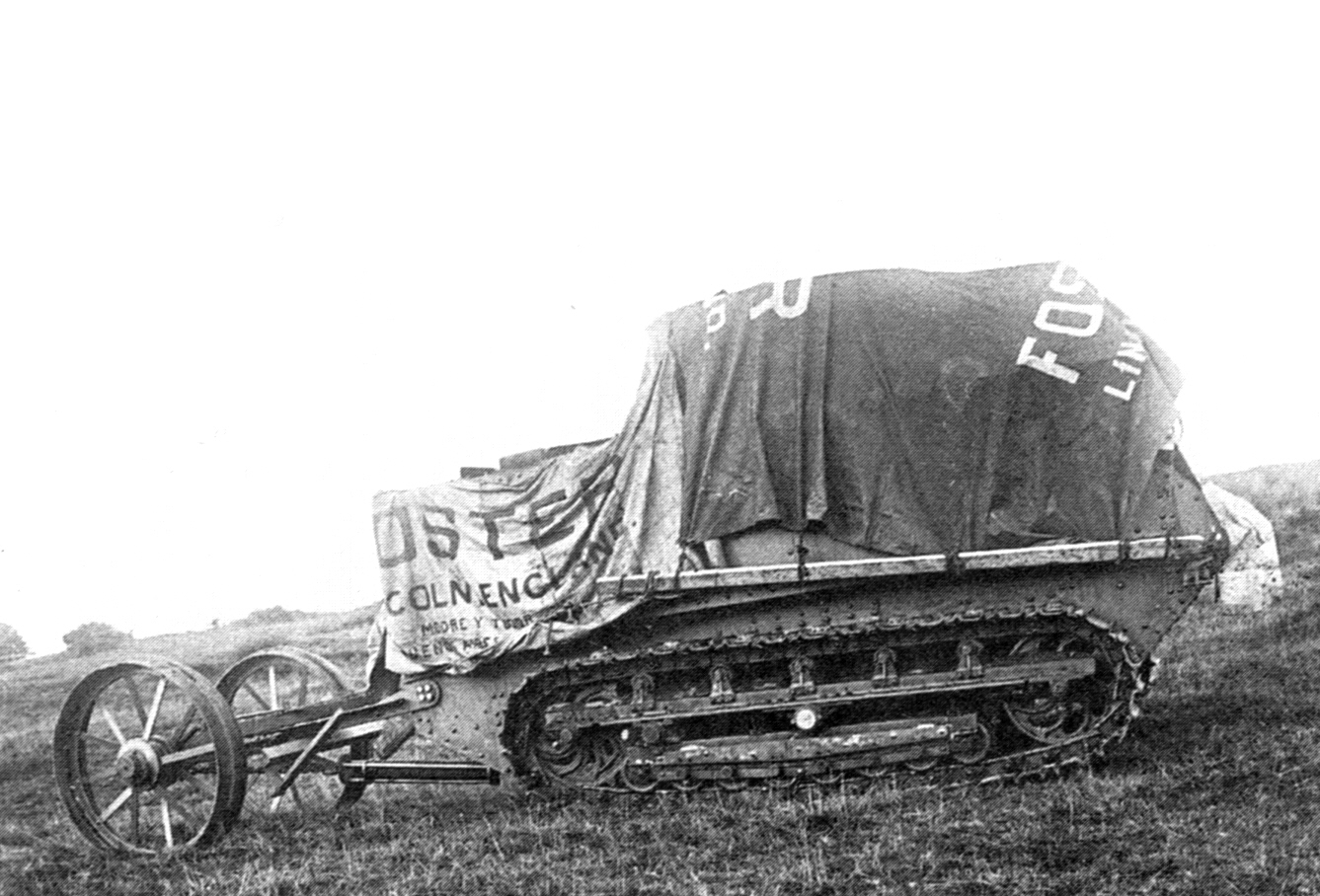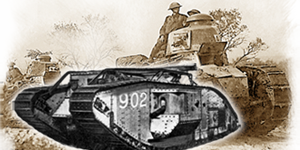Genesis of the Concept
The very first British tank (and the first in the world at the same time) derived from a number of projects dating back to the early 1915 stalemate. Then the first ideas advocated less for an armored fighting vehicle and more for a way to clear up barb wire, which was usually covered by direct, accurate machine gun fire. The alternative at the time were night operations by small detachments, but these were tricky.A noise (tin cans were often attached to the supports of the barb wire), a flare, and then heavy fire caused havoc on the raiding party. Later, other experiments included the reintroduction of the cuirass, various man-carried protections, but each time they were shown to be of little use against bullets, prone to concussions and the legs and arms of the operators were not protected. A big wheel with spinning hooks mounted on the front of a Holt tractor was the preferred concept at the time. But the need to protect the driver and the evolution of military thinking led to the "land cruisers", which ultimately never left the drawing board.
Origins
Despite its seemingly cute name the "Little Willie" was in fact a impressive war machine conceived to punch a hole in the German lines. It was officially named a "tank" to deceive any enemy intelligence on the project. The "Little Willie" was the origin of all the British tank development during World War One. In fact, the original project initiated by the Landships Committee was picturing a vehicle capable of crossing any kind of trenches and destroying barb wire in the process. The Landships Committee was established in February 1915 as a small British War Cabinet commission, headed by the first Lord of Admiralty, Sir Winston Churchill, and composed of various politicians, engineers and officers, with the goal of producing the first armored vehicle before the end of 1915.The original idea, which provided the basis for the project, came from Col. Ernest Swinton and was promoted by Col. Maurice Hankey. The whole project was later supported by Churchill himself, whom was aware that such a concept could turn the tide of trench warfare in favor of the side which possessed the "landships" (H. G. Well's writings had provided inspiration). The Navy also had interests in the project, not only because of Churchill, but because this was a development for enclosed guns. Among those who took some early interest were Thomas Hetherington and Col. Wilfred Dumble of the Royal Brigade.
Testing the Lincoln Machine
The track was indeed the major source of trouble throughout the test campaign. The first version was directly inspired only a strengthened tractor track. But due to the sheer weight of the hull and the mud, traction resistance of the plain, flat track was just too much for the tiny engine, which also led to poor steering. Other tracks were tested until Lt. Gordon Wilson ultimately delivered the right solution. A combination of new, hard-steel plates riveted to links with guides to be firmly kept in place, and connected to the hull with large spindles. This was done by the end of September, and ultimately proven by far the most reliable system.It was kept for every British tank in the war, although it limited speed. The motor was a powerful 105 bhp Daimler Benz at the back of the hull (the basis was the Foster-Daimler tractor), fed by one internal and two external fuel tanks. Armament was designed to be made up of one standard Vickers 2-pounder gun with 800 rounds and no less than six Madsen 7.7 mm (0.303 in) Machine guns. A dummy turret was tested and plans included large openings to laterally aim the gun, which was mounted on a rail system. Intended crew was six at least, and protection was assumed by 10 mm bullet-proof riveted plates.
Pre-production
Wilson, whom headed the project, felt the first prototype did not satisfy his expectations and built a second one, the HMLS Centipede, Mk. I. It included a rhomboid track frame with the armament mounted on sponsons in the hull after the removal of the turret. The first prototype was also rebuilt, with a longer track and other minor modifications. In December, the first prototype was renamed "Little Willie" after the yellow press mocking the German Imperial Crown Prince Wilhelm, and the second "Big Willie" after his father. But after popular reception and further extensive tests, only the concept of Big Willie was retained for production (although the first British tank series differed in many aspects). It was, in January 1916, the world's first pre-production tank prototype, one month before the French Schneider CA-1 made its debut.Design
Thomas Hetherington, supported at first by Churchill, proposed a real "land ironclad", weighing about 300 tons, equipped with a large range of guns and machine guns. But while the idea was attractive on paper, not even naval-grade engines could match up to such a monster. But the idea of a heavy cross-country vehicle made its debut. An artillery tractor was soon envisioned as the basis for a more practical design. In July 1915, after many discussions, a specification was issued for a war engine able to cross a 1.5 m (5 feet) trench. This was the start of a project rush and, in the end, the winner was William A.Tritton of the agricultural William Foster & Co of Lincoln. He had given an order to produce a double tracked prototype based on a design by Tritton's chief engineer, William Rigby. This was to be based on the Creeping Grip Tractor of the Bullock company from Chicago, a fairly crude, but sturdy system. In just a month (beginning in mid-August), the first prototype, called N°1 Lincoln Machine, was ready for tests, already fitted with a wheeled tail for better steering. On the 5th of September the Lincoln machine was tested at the Wellington foundry yard. Many improvements for the tracks and suspension were done during the process.

The N°1 Lincoln Machine on trials, September 1915. This first design incorporated, almost without changes, the original Daimler tracks, which came from an artillery tractor and proved too flimsy and short for the large hull. The dummy turret (here covered) was assumed to use the light, naval, quick firing Vickers 2 pounder (40 mm), against machine gun nests, but was never fitted in this configuration. Later tests were made with the gun mounted in a sponson, another naval feature.
Fate and Further Development
Little Willie (now at the Bovington museum) was the basis for the Medium Mk. A "Whippet" as well as for the tracks of the production Mk. I. As the length of the tracks proved so important to cross obstacles, subsequent trials on the new Mk. I tank led to the famous lozenge design, where the tank had its tracks run the whole length and height. There was not yet any concept of separating tanks with guns and tanks with machine guns ("male and female"), as the prototype was a "male", combining six machine guns and a gun in a sponson (also a naval feature). The crew would probably have been made of seven persons, in a confined, dark, hot, steamy and noisy environment.It had no suspensions at all, so any bumps on the ground were fully resented. The dummy turret preceded the Renault FT-17 concept by a year at least, but the steering system was not yet even conceived. Many considered the tank too high and an easy target for enemy guns. The relatively lightly armored hull was largely considered sufficient, but the Germans later proved that a single hollow-charge armor-piercing bullet, available for any rifle, could be lethal against tanks. As there were no antitank guns at the time, a direct hit by a 75 mm or larger shell would have been lethal as well. There was a long way to go before sloped armor and more refined protections.

Little Willie Prototype Specifications |
|
| Dimensions (L-w-h) | 5.87x2.86x2.51 m (19x9x8 feet) |
| Total weight, battle ready | 16.5 tons |
| Crew | 6 |
| Propulsion | Foster-Daimler Knight sleeve valve petrol 105 hp |
| Speed | 3.22 km/h (2 mph) |
| Range/consumption | 30 km/800 liters (18.64 mi) |
| Armament | Vickers 2 Pdr (40 mm) Mk. II 6 Vickers 7.7 mm (0.303 in) machine guns |
| Armour | From 10 to 15 mm (0.39-0.59 inches) |
| Total production | One prototype |

Little Willie with its tailwheel mounted for tests in December 1915.
Links about the Little Willie
On Wikipedia

The Little Willie, as it appeared after its final modifications, in December 1915. Since the first Lincoln machine trials it was fitted with an extra tail-wheel to enhance steering and for crossing large trenches. This feature was successful and retained for the subsequent Mk.I British tank. The specially designed track system was also considered a success. Unlike the previous design, the longer tracks made it better able to cross all kind of difficult, muddy ground, especially trenches and the removal of the turret added some stability.

The Great War
 Austria-Hungary
Austria-Hungary Belgium
Belgium British Empire
British Empire France
France German Empire
German Empire Italy
Italy Russia
Russia USA
USAWW1 tanks posters

